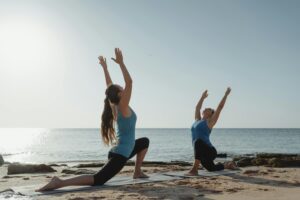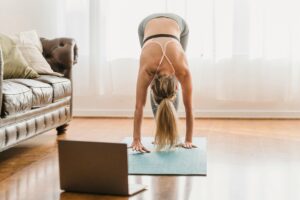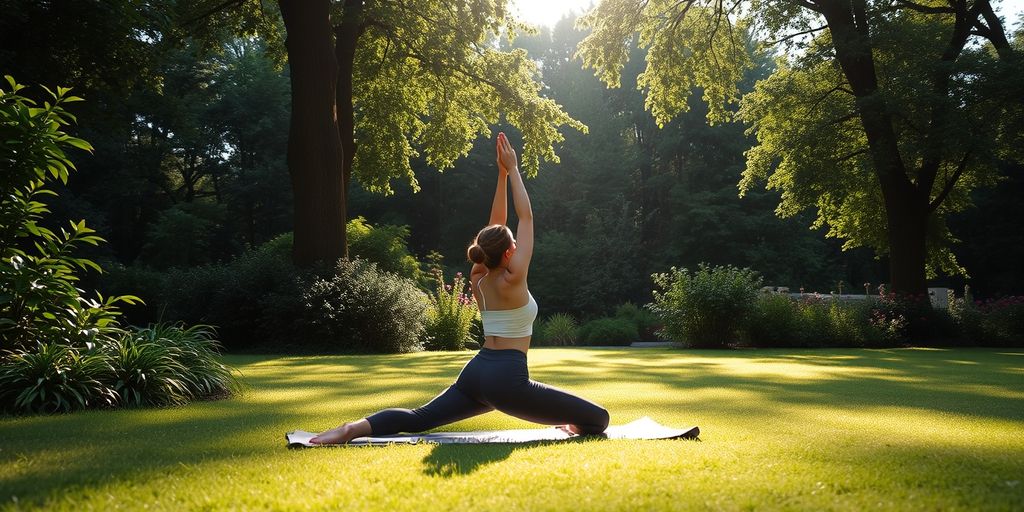Feeling stressed and overwhelmed? Yoga can be a great way to relax and find some peace. It’s easy to start, and you don’t need any special equipment. Just a little space and some quiet time will do. Here are Top 5 Yoga Poses For Relaxation And Stress Management so that you feel calmer and more relaxed.
Key Takeaways
- Child’s Pose (Balasana) helps you relax and calm your mind by stretching your back and hips.
- Legs-Up-the-Wall Pose (Viparita Karani) is great for reducing stress and improving circulation.
- Corpse Pose (Savasana) allows you to fully relax your body and mind, making it perfect for ending your yoga session.
Top 5 Yoga Poses For Relaxation And Stress Management
Top 5 Yoga Poses for Relaxation and Stress Management” offers a guide to simple yet effective yoga poses designed to help you unwind and de-stress. These poses can calm the mind, release tension, and promote overall well-being, making them ideal for anyone looking to find peace in their daily routine.
1. Child’s Pose (Balasana)

Child’s Pose, or Balasana, is a simple yet powerful pose that helps us relax and find peace. It’s perfect for those new to yoga, making it a great yoga for beginners posture.
To get into Child’s Pose, start on your hands and knees. Sit back onto your heels and stretch your arms out in front of you. Let your torso rest on your thighs. Your big toes should touch, and you can keep your knees together or apart, depending on what feels best for your hips. Take at least ten deep breaths, focusing on letting go of any tension.
Benefits of Child’s Pose
- Opens hips and lengthens the spine
- Relieves physical and mental exhaustion
- Reduces anxiety and promotes serenity
Tips for Practicing Child’s Pose
- If your hips are tight, place a cushion between your backside and heels.
- With each exhale, try to release as much air as possible.
This pose is a restful yet challenging way to create a moment of peace in our busy lives. Embrace the stillness and listen to your body.
Child’s Pose is more than just a stretch; it’s a way to connect with ourselves and find calm in the chaos.
2. Legs-Up-the-Wall Pose (Viparita Karani)

Feeling stressed? Let’s try the Legs-Up-the-Wall Pose, also known as Viparita Karani. This pose is a fantastic way to promote relaxation and stress alleviation. It’s super easy and can be done almost anywhere.
How to Do It
- Sit next to a wall and gently swing your legs up along the wall as you recline back.
- Make sure your back and head are resting comfortably on the floor.
- Place your arms by your sides, palms facing upwards, and breathe deeply.
- Hold this pose for five minutes or as long as it feels comfortable.
Benefits
- Increases flexibility in the back of your legs and neck.
- Helps with lymph drainage and improves blood circulation.
- Calms your mind and heart, making it a great pose to do before bedtime.
This pose is perfect for draining tension from the legs and feet, relaxing your lower body, and promoting overall calmness.
So, next time you’re feeling overwhelmed, find a wall and give Viparita Karani a try. You’ll feel the stress melt away!
3. Corpse Pose (Savasana)

Corpse Pose, or Savasana, is often the final pose in a yoga session. It might look simple, but it can be quite challenging to master. This pose is all about total relaxation and letting go of tension.
How to Do Corpse Pose
- Lie flat on your back with your legs slightly apart and your arms at your sides, palms facing up.
- Close your eyes and take deep breaths, focusing on each inhale and exhale.
- Gradually bring your attention to each part of your body, starting from your head and moving down to your toes, releasing any tension.
- Stay in this pose for three to five minutes, allowing your body to fully relax.
Benefits of Corpse Pose
- Relieves muscular and skeletal tension
- Reduces stress and anxiety
- Calms your mind and improves concentration
- Helps with insomnia and stimulates blood circulation
Savasana is a powerful pose that helps us absorb all the benefits of our yoga practice. It’s a moment to let go of our fears and worries, sinking into a state of complete relaxation.
Remember, relaxation doesn’t happen on demand. It takes practice, but once you get the hang of it, Savasana can be incredibly rewarding.
4. Cat-Cow Pose (Marjaryasana to Bitilasana)
Cat-Cow Pose is a fantastic way to warm up your spine and get your body moving. This pose is a combination of two movements: Cat Pose (Marjaryasana) and Cow Pose (Bitilasana). When we flow between these two poses, we can release tension and improve flexibility.
How to Do Cat-Cow Pose
- Start in a Tabletop Position: Place your hands directly under your shoulders and your knees under your hips.
- Inhale and move into Cow Pose: Drop your belly towards the floor, lift your chin and chest, and gaze forward.
- Exhale and transition to Cat Pose: Pull your belly to your spine, round your back towards the ceiling, and drop your head.
- Continue to flow between Cat and Cow with each breath, feeling the stretch from your tailbone to the crown of your head.
This pose is perfect for a morning yoga routine to wake up your body and mind.
Benefits of Cat-Cow Pose
- Reduces stress and fatigue
- Improves circulation
- Enhances spinal flexibility
- Calms the mind and body
Incorporating Cat-Cow Pose into your daily practice can help you feel more relaxed and energized. Whether you’re new to Yoga or a seasoned practitioner, this pose is a great addition to your routine. So, let’s get on our mats and flow through some Cat-Cow!
5. Forward Bend (Uttanasana)

Forward Bend, or Uttanasana, is a fantastic pose for stretching the entire body. It helps to reduce stress and fatigue by stimulating the liver and kidneys. This pose also stretches the hamstrings, calves, hips, and back, making it a great all-around stretch.
How to Do Forward Bend
- Start from a neutral standing position (Tadasana).
- Bend your knees slightly and hinge forward from your hips, placing your hands in front of your feet.
- Shift the weight to the balls of your feet. If your hamstrings are tight, keep your knees bent to avoid straining your lower back.
- Grab each elbow with the opposite hand and let your head hang down.
- Hold the pose for five breaths, then slowly rise back up to Tadasana.
Tips
- Imagine your worries flowing from your head down to your feet and being absorbed by the ground.
- Take your time coming out of this pose, especially if you have low blood pressure.
This pose is not just a physical stretch but also a mental release. It helps us let go of stress and anxiety, leaving us feeling refreshed and relaxed.
Conclusion
Incorporating yoga into your daily routine can be a game-changer for managing stress and finding relaxation. These five poses are simple yet powerful tools to help you calm your mind and rejuvenate your body. Remember, the key is consistency and listening to your body. Start with a few minutes each day, and gradually increase your practice as you become more comfortable. With time, you’ll likely find that these poses not only help you cope with stress but also improve your overall well-being. So, roll out your mat, take a deep breath, and embrace the journey to a more relaxed and balanced life.
Frequently Asked Questions
How often should I practice yoga for stress relief?
It’s best Yoga Poses For Relaxation And Stress Management , at least a few times a week. Even short sessions can be beneficial. Listen to your body and do what feels right for you.
Do I need any special equipment to do these yoga poses?
No special equipment is needed to start these yoga poses. A yoga mat can be helpful for comfort, but you can also use a towel or practice on a soft surface.
Can beginners do these yoga poses?
Yes, these yoga poses are suitable for beginners. They are simple and can be modified to fit your comfort level. Always listen to your body and take it slow if you’re new to yoga.



